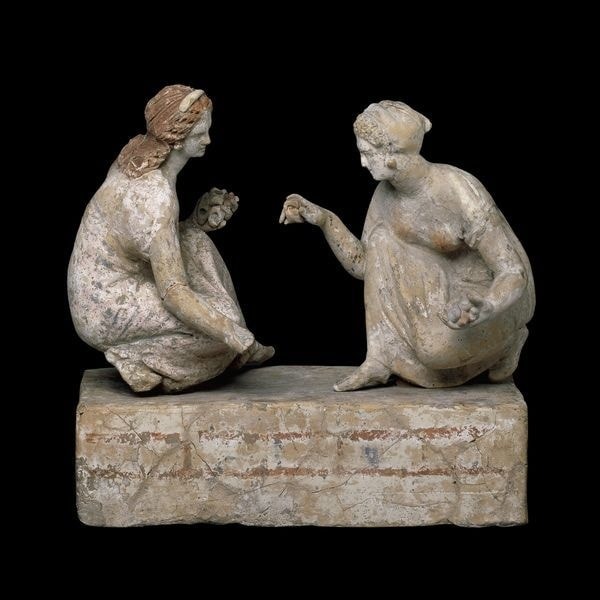Introduction to the Artwork
The clay figurine depicting two girls playing knucklebones is a prime example of Etruscan art, created by an anonymous artist around the 3rd century BC. This game, popular in many ancient cultures, was not only a pastime but also an important part of social and cultural life in Etruscan society.
The Image in the Artwork
The artwork shows two girls seated, gently holding small bones, which are part of the knucklebones game. This simple yet skillful game involved tossing and catching the bones in various ways, requiring dexterity and precision. The way the girls interact with each other in the figurine, along with their natural facial expressions and lifelike movements, demonstrates the artist’s attention to detail and emotional depth in capturing the moment.
The Significance of the Knucklebones Game
Knucklebones was more than just a game—it also had ritualistic and social significance. Played from ancient Greece to Rome, the game was widespread across many civilizations, including the Etruscans. In Etruscan culture, knucklebones might have been used not only for recreation but also for communication, learning, or even as part of religious ceremonies. Images in Etruscan art depicting such games show that play was an integral part of social life, reflecting both enjoyment and interaction within the community.

Analysis of Etruscan Art
Etruscan art, especially works depicting everyday life, is known for its naturalistic and refined style. Etruscan artists sought to capture detailed and lifelike representations, from bodily movements to surrounding objects. This particular piece is no exception, as the girls are portrayed in a natural, relaxed pose, displaying the artist’s keen observation skills and ability to record vibrant moments of life.
This style reflects one of the defining characteristics of Etruscan art—the ability to blend beauty with reality, portraying both mundane aspects of daily life and more symbolic or supernatural elements. Etruscan art is known for its close connection to nature and communal life, as well as its emphasis on human expression.
The Role of Art in Etruscan Society
Etruscan art served not only as decoration but also as a means to record events, moments, and activities of daily life. This figurine is more than just a playful depiction; it is a reflection of how the Etruscans valued joy, communication, and social relationships. Representing everyday moments in art highlights the Etruscans’ reverence for daily life and interactions, whether in games or more solemn ceremonies.
Conclusion
The Etruscan clay figurine of two girls playing knucklebones is not only a beautifully crafted work of art but also a window into the life of the Etruscan people. It reflects social values, leisure activities, and the human connections that were central to Etruscan culture. This piece demonstrates the skill of Etruscan artists in capturing the vibrancy of life, offering a glimpse into the richness of their society. As part of the cultural heritage of one of Italy’s most influential ancient civilizations, this artwork contributes to our understanding of their lasting influence on Western art and culture.
